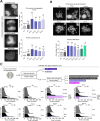Quantitative proteomic and phosphoproteomic comparison of human colon cancer DLD-1 cells differing in ploidy and chromosome stability
- PMID: 29496963
- PMCID: PMC5921571
- DOI: 10.1091/mbc.E17-10-0577
Quantitative proteomic and phosphoproteomic comparison of human colon cancer DLD-1 cells differing in ploidy and chromosome stability
Abstract
Although aneuploidy is poorly tolerated during embryogenesis, aneuploidy and whole chromosomal instability (CIN) are common hallmarks of cancer, raising the question of how cancer cells can thrive in spite of chromosome aberrations. Here we present a comprehensive and quantitative proteomics analysis of isogenic DLD-1 colorectal adenocarcinoma cells lines, aimed at identifying cellular responses to changes in ploidy and/or CIN. Specifically, we compared diploid (2N) and tetraploid (4N) cells with posttetraploid aneuploid (PTA) clones and engineered trisomic clones. Our study provides a comparative data set on the proteomes and phosphoproteomes of the above cell lines, comprising several thousand proteins and phosphopeptides. In comparison to the parental 2N line, we observed changes in proteins associated with stress responses and with interferon signaling. Although we did not detect a conspicuous protein signature associated with CIN, we observed many changes in phosphopeptides that relate to fundamental cellular processes, including mitotic progression and spindle function. Most importantly, we found that most changes detectable in PTA cells were already present in the 4N progenitor line. This suggests that activation of mitotic pathways through hyper-phosphorylation likely constitutes an important response to chromosomal burden. In line with this conclusion, cells with extensive chromosome gains showed differential sensitivity toward a number of inhibitors targeting cell cycle kinases, suggesting that the efficacy of anti-mitotic drugs may depend on the karyotype of cancer cells.
Figures







References
-
- Adams ND, Adams JL, Burgess JL, Chaudhari AM, Copeland RA, Donatelli CA, Drewry DH, Fisher KE, Hamajima T, Hardwicke MA, et al (2010). Discovery of GSK1070916, a potent and selective inhibitor of aurora B/C kinase. J Med Chem , 3973–4001. - PubMed
-
- Ahrné E, Glatter T, Viganó C, Schubert CV, Nigg EA, Schmidt A. (2016). Evaluation and improvement of quantification accuracy in isobaric mass tag-based protein quantification experiments. J Proteome Res , 2537–2547. - PubMed
-
- Alexa A, Rahnenfuhrer J, Lengauer T. (2006). Improved scoring of functional groups from gene expression data by decorrelating GO graph structure. Bioinformatics , 1600–1607. - PubMed
-
- Alvaro D, Sunjevaric I, Reid RJD, Lisby M, Stillman DJ, Rothstein R. (2006). Systematic hybrid LOH: a new method to reduce false positives and negatives during screening of yeast gene deletion libraries. Yeast , 1097–1106. - PubMed
Publication types
MeSH terms
Substances
LinkOut - more resources
Full Text Sources
Other Literature Sources
Miscellaneous

